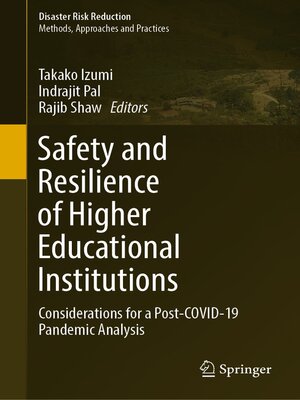Safety and Resilience of Higher Educational Institutions
ebook ∣ Considerations for a Post-COVID-19 Pandemic Analysis · Disaster Risk Reduction
By Takako Izumi

Sign up to save your library
With an OverDrive account, you can save your favorite libraries for at-a-glance information about availability. Find out more about OverDrive accounts.
Find this title in Libby, the library reading app by OverDrive.



Search for a digital library with this title
Title found at these libraries:
| Library Name | Distance |
|---|---|
| Loading... |
The world has spent the majority of 2020 enduring an unpreceded crisis caused by the COVID-19 pandemic. The impact of this crisis has been enormous, and the situation has yet to be resolved. It is still difficult to anticipate when the pandemic will end and how our lives will have changed after the crisis.
Higher educational institutions (HEIs) have also had to undergo tremendous transformation, in particular, changing a conventional educational, teaching, and learning system to a digital and online mode and cancelling or postponing important events such as graduation and entrance ceremonies and entrance examinations. In addition, a number of HEIs have been facing financial constraints due to reduced enrolment, particularly from overseas. Students have missed opportunities to meet their family and friends, causing profound psychosocial impact and stress for all concerned.
Simultaneously, however, the situation has given HEIs a good opportunity to consider their disaster preparedness, response, and recovery capacity on campus. Some surveys have highlighted a lack of preparedness for pandemic and other hazardous risks beyond natural hazards. Safety issues are a top priority at HEIs because they bring together a number of students, faculty, and staff.
This book covers the experiences and lessons learned from HEIs in preparedness, response, and recovery during the COVID-19 pandemic to prepare for such calamities beyond natural disasters in the future. The book consists of 15 chapters divided into three major sections. They highlight the importance of HEIs' governance issues in disaster risk management, examine the challenges that HEIs have faced during the pandemic and the implementation of new teaching and learning methodologies, and provide innovative responses and preparedness by HEIs based on science and technology, respectively.
Higher educational institutions (HEIs) have also had to undergo tremendous transformation, in particular, changing a conventional educational, teaching, and learning system to a digital and online mode and cancelling or postponing important events such as graduation and entrance ceremonies and entrance examinations. In addition, a number of HEIs have been facing financial constraints due to reduced enrolment, particularly from overseas. Students have missed opportunities to meet their family and friends, causing profound psychosocial impact and stress for all concerned.
Simultaneously, however, the situation has given HEIs a good opportunity to consider their disaster preparedness, response, and recovery capacity on campus. Some surveys have highlighted a lack of preparedness for pandemic and other hazardous risks beyond natural hazards. Safety issues are a top priority at HEIs because they bring together a number of students, faculty, and staff.
This book covers the experiences and lessons learned from HEIs in preparedness, response, and recovery during the COVID-19 pandemic to prepare for such calamities beyond natural disasters in the future. The book consists of 15 chapters divided into three major sections. They highlight the importance of HEIs' governance issues in disaster risk management, examine the challenges that HEIs have faced during the pandemic and the implementation of new teaching and learning methodologies, and provide innovative responses and preparedness by HEIs based on science and technology, respectively.







